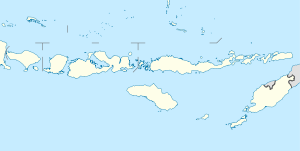Southern lamas
| Kecamatan Lamaknen Selatan South Lamaknen District
|
|
|---|---|
| Basic data | |
| Country | Indonesia |
| province | East Nusa Tenggara |
| Administrative district | Belu |
| Seat | Lutha Rato |
| Residents | 7312 (2010) |
| ISO 3166-2 | ID-NT |
Coordinates: 9 ° 8 ′ S , 125 ° 10 ′ E
Location in East Nusa Tenggara Province
|
South Lamaknen ( Lamaknen Selatan ) is an Indonesian district ( Kecamatan ) in the administrative district ( Kabupaten ) Belu (province of East Nusa Tenggara ).
geography
South Lamaknen is located in the far east of the Indonesian West Timor and is bordered to the east and south by the municipalities of Bobonaro and Cova Lima , which are part of the East Timor state .
The district of South Lamaknen is divided into Desas Debululik (1167 inhabitants 2010), Lutha Rato (886), Henes (503), Lakmaras (1106), Nualain (793), Ekin (770), Loonuna (1349) and Sisi Fatuberal (738 ).
The administrative seat is in Lutha Rato.
Residents
The majority of the 7,312 inhabitants (2010) belong to the Bunak ethnic group , who otherwise live in the neighboring East Timor.
history
The region was long disputed between the colonial powers Portugal and the Netherlands . According to the The Hague Convention of October 1, 1904, Portugal was to receive the Dutch enclave Maucatar , for which the border areas Tahakay (Tahakai) , Tamira Ailala (Tamiru Ailala) and Lamaknen and the Portuguese enclave Noimuti were assigned to the Netherlands. Portugal ratified the treaty until 1909, but then there was a dispute over the demarcation of the eastern border of the Portuguese exclave Oe-Cusse Ambeno further west. The Netherlands took advantage of the confusing situation in the neighboring colony after the fall of the Portuguese monarchy in 1910 to appropriate the territory of the Lakmaras Empire with European and Javanese troops.
When Portugal tried to occupy Maucatar with troops in February 1911, in June they were faced with a superior Dutch force made up of Ambonian infantry, supported by European soldiers. On June 11th, the Portuguese occupied the disputed territory of Lakmaras , but on July 18th, Dutch and Javanese troops invaded again. Three Mozambicans died, and Lieutenant Francisco da Costa and his men were taken prisoner. After the victory of the Dutch, they now sought a peaceful settlement. The Portuguese were soon troubled by the Manufahi rebellion , which made them ready to negotiate. After a lengthy exchange of letters between the cabinets of the Länder, an agreement was reached in the 1913 Convention to leave the decision on the disputes to an arbitrator. On June 25, 1914, the Permanent Court of Arbitration in The Hague issued an arbitral award (Sentenca Arbitral) . The land survey work was completed in April 1915. On August 17, 1916, the treaty was signed in The Hague, which largely defined the border between East and West Timor that still exists today.
In 1933, Lamaknen is described as a union of the Bunak realms of Makir , Lamak Senulu (Lamaksanoeloe), Kewar , Leowalu (Leowaloe), Loonoena, Nualain (Noealain, Noalain), Lakmaras and Dirun (Diroen). The ruler of Dirun held the title of Fettor , while the others were called Rajas by the Dutch . Tahakay also became part of Lamaknen after it was taken over by the Dutch in 1904.
The Lorohs of Lamaknen were traditionally provided by the Rajas of Kewar and Lakmaras, with Lakmaras representing the non-active ruler who symbolized the unity and from Kewar the actual ruler came. After the Second World War , the Dutch officially recognized the empire.
The common ruler was chosen by the various noble families. They came from Kewar, Lakmaras, Henes, Nualain, Makir, Lamak Senulu, Fulur , Leowalu, Duarato , Ekin, Loonuna (Lona) and Dirun.
For the rulers of Lamaknen see History of Lamaknens .
Individual evidence
- ^ A b c Antoinette Schapper: Crossing the border: Historical and linguistic divides among the Bunaq in central Timor
- ↑ a b Penduduk Indonesia menurut desa 2010 ( Memento from March 27, 2014 in the Internet Archive ) (Indonesian; PDF; 6.0 MB), accessed on January 26, 2013
- ↑ Yustinus Nahak: Kecamatan di Kabupaten Belu . June 23, 2012, accessed July 28, 2014.
- ↑ a b Geoffrey C. Gunn: History of Timor ( Memento of the original from March 24, 2009 in the Internet Archive ) Info: The archive link was inserted automatically and has not yet been checked. Please check the original and archive link according to the instructions and then remove this notice. , Technical University of Lisbon (PDF file; 805 kB)
- ↑ Hague Justice Portal: Island of Timor: Award - Boundaries in the Island of Timor ( page no longer available , search in web archives ) Info: The link was automatically marked as broken. Please check the link according to the instructions and then remove this notice. (English)
- ↑ "Part 3: The History of the Conflict" ( Memento of the original from July 7, 2016 in the Internet Archive ) Info: The archive link was inserted automatically and has not yet been checked. Please check the original and archive link according to the instructions and then remove this notice. (PDF; 1.4 MB) from the "Chega!" Report by CAVR (English)
- ^ Encyclopedie van Ned. O-Indie (1933)
- ↑ a b Royal Timor: Llamaknen ( Memento from November 20, 2008 in the Internet Archive )

